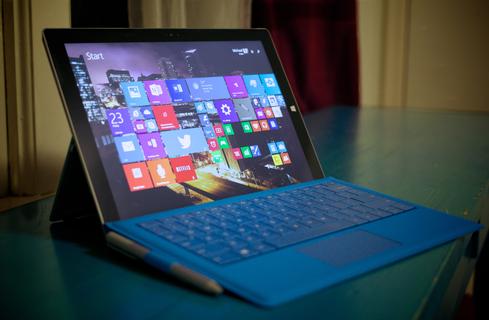Microsoft Surface Pro 3: Customers SpeakMicrosoft Surface Pro 3: Customers Speak
Early adopters of Microsoft's Surface Pro 3 say the Windows device is working well as a tablet and an ultra-light laptop.


Surface Pro 3 Vs. World: Mobile Smackdown
Surface Pro 3 Vs. World: Mobile Smackdown (Click image for larger view and slideshow.)
The Surface Pro 3 has earned better reviews than its predecessors -- but most of the commentary has come from tech journalists, who, let's face it, are an awfully keyboard-dependent, word processing-oriented bunch. What are Microsoft's actual customers saying? We spoke to IT decision-makers at Seattle Children's Hospital and University of Pittsburgh Medical Center (UPMC), two early Surface Pro 3 adopters to find out how and why they've chosen to deploy the device.
The Surface Pro 3 is technically a tablet, and Microsoft still sells its Type Cover keyboard separately. Nevertheless, both organizations were attracted to the device's laptop capabilities.
"It's the thinnest Ultrabook ever created," UPMC VP of Medical Information Technology Rasu Shrestha said of the Pro 3's appeal.
[On the fence about the Surface Pro 3? Read Microsoft Surface Pro 3: Why To Buy.]
"The mobility of it, the lightness, the kickstand, the screen size," said Seattle Children's CIO Wes Wright. "It hits a bunch of our complaints from the originals [and] makes it much more viable in a health care setting."
Despite a shared enthusiasm for the Pro 3's laptop mode, each organization plans to use the Pro 3 in somewhat different ways. Wright said Seattle Children's plans to deploy around 1,000 devices, 300 of which are destined for clinical use. The rest are pegged for non-medical staff, such as those in the finance and supply chain departments.
Figure 1:
The hospital had previously deployed around 150 Surface Pro and Surface Pro 2s, mostly as notebook replacements for execs and administrative departments. Similarly, the majority of the hospital's Pro 3s will serve first and foremost as ultralight laptops. But Wright said the Pro 3's hybrid qualities will play a bigger role among the 300 devices earmarked for doctors.
All of Seattle Children's Surfaces will rely on a Windows 7 virtual desktop for shared resources because "the fat app changes often, and rather than trying to touch 6,000 devices, it just makes more sense for us to serve up a single virtualized image," Wright said. But whereas most of the Pro 3s will be managed like typical corporate-issued devices, the clinicians' units will "probably be issued in more of a personal device mode.
"If I just gave them a laptop, I wouldn't get any innovation out of [the doctors]," Wright said, noting that the Surface Pro Pen opens up new ways for doctors to use tablets.
UPMC plans to deploy most of its 2,000 Surface Pro 3s to physicians. Microsoft touted earlier Surfaces as a way for doctors to access and modify Electronic Health Record (EHR) systems on-demand, enabling them to work more effectively with patients, and avoid running to a computer workstation between appointments. UPMC's deployment taps this vein, but with the added twist that the hospital is developing its own EHR product, Convergence.
A Windows 8.1 app, Convergence pulls information from multiple EHR systems and allows doctors to switch between a visual view of a patient's records, and those underlying systems. UPMC will serve as a "living lab" as the Convergence team prepares to bring the app to market, Shrestha said. UPMC originally planned to build Convergence on iOS but
switched to Windows because iPads would allow doctors only to view records, but not to modify them.
UPMC also hopes Convergence will help address ones of Windows 8.1 and the Pro 3's chief weaknesses against the iPad -- a lack of quality touch apps. Most big ERM vendors focus on iOS because it has the most users, said Seattle Children's CIO Wright.
Despite the ongoing app gap, both Wright and Shrestha expressed enthusiasm over the Pro 3's hybrid capabilities -- not the tiled Start screen, per se, but the new pen, which replaces the previous Pros' Wacom-based stylus with N-trig technology. As noted, some employees will treat their Surfaces as ultralight, ultrathin laptops -- but for doctors in particular, the pen adds another dimension.
When Wright said the Pro 3 enabled more innovation than a laptop, he spoke specifically about the pen. "It really has the best handwriting experience, closer to a paper experience than any other tablet I've ever used," he said. Seattle Children's doesn't yet have specific plans for how the pen might be used, but "with [Windows 8.1's] handwriting recognition, there's the potential that I can integrate that with the EMR we use daily."
Dr. Maida Chen, medical director for sleep disorders at Seattle Children’s Hospital, has previously lauded the pen. "When we have very quickly evolving situations with patients, jotting down notes is still the way that most clinicians go," she said.
Figure 2: 
Shrestha noted that clinicians like to draw while explaining conditions to patients. He added that doctors will also enjoy taking quick notes that can later be converted to text, and that the pen can also be used as a mouse device.
Though Wright and Shrestha praised the Pro 3, neither pretends it's the perfect device for all employees.
"We're continuing to push ahead with our BYOD strategy, looking at iOS and Android alongside Windows mobile phones," Shrestha said, though he added that for core clinical workflows, such as interacting with EMRs, the Pro 3 is an ideal candidate.
"Most of our day-to-day work is in a virtualized environment," Wright said. "We're working with Citrix and Microsoft [on Windows 8.1 virtualization] that will serve up touch-enabled apps to anyone with a touch-enable devices, be it iPad or Surface or Android."
He mentioned that some Seattle Children's employees, including many scientists in the hospital's Research Institute, use Apple computers. "My chief medical information officer, he uses a MacBook Pro," Wright said. "He does a lot of stats and graphics. He's interested in whether the Surface Pro 3 can give him the performance [of the MacBook]."
Wright isn't overwhelmingly concerned about the Pro 3's power, however; 60% of Seattle Children's 1,000 Surface Pro 3s will be the low-end model configured with Intel's Core i3 chip, and only 10%% will use Intel's high-end i7 processor. But as the comparison between the Pro 3 and MacBook attests, Microsoft's tablet isn't likely to become the only device Seattle Children's IT staff has to manage.
Even if Seattle Children and UPMC achieve successful deployments, those experiences may not portend much for the Surface Pro 3's overall prospects. After all, early Surfaces attracted high-profile corporate customers, such as Delta. But Microsoft's tablets -- and Windows slates in general -- have barely registered in the overall market.
The Pro 3 has already attracted other notable commercial customers, including BMW and Coca Cola. The device has been on the market since June 20, and Microsoft's so far been mum on sales figures. Time will tell if the Surface line, which has still yet to turn a profit, has finally turned a corner.
At least one customer is optimistic, though. "I really think they've got a hit," Wright said.
information's new Must Reads is a compendium of our best recent coverage of the Internet of Things. Find out the way in which an aging workforce will drive progress on the Internet of Things, why the IoT isn't as scary as some folks seem to think, how connected machines will change the supply chain, and more. (Free registration required.)
About the Author
You May Also Like






